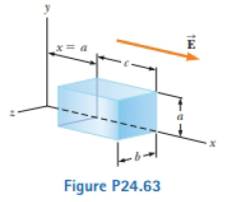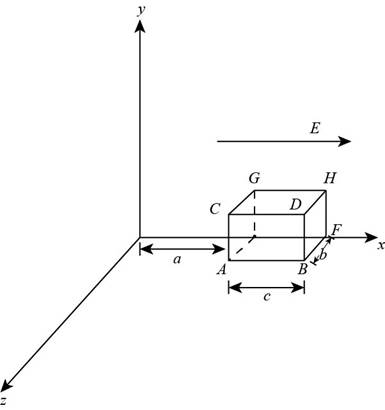
Concept explainers
A dosed surface with dimensions a = b= 0.400 111 and c = 0.600 in is located as shown in Figure 1*24.63. The left edge of the closed surface is located at position x = a. The electric field throughout the region is non- uniform and is given by →E = (3.00 + 2.00x2)i N/C, where x is in meters. (a) Calculate the net electric flux leaving the closed surface. (b) What net charge enclosed by the surface?

(a)
The net electric flux leaving the closed surface.
Answer to Problem 24.63CP
The net electric flux leaving the closed surface is 0.269 N⋅m2/C.
Explanation of Solution
Given info: The dimensions of the closed surface are a=b=0.400 m and c=0.600 m and the electric field is given by →E=(3.00+2.00x2)ˆi N/C.
The position of the closed surface is,

Figure (1)
From the figure (1) the electric field is perpendicular to the normal of area ABEF, area CDHG, area ABCD and the area EFGH. Therefore,
The formula to calculate electric flux is,
ϕ=EAcosθ (1)
Here,
E is the magnitude of the electric field crossing the area.
A1 is the area of the closed surface.
θ is the angle between the normal to surface area of rectangular plane and the electric field.
The electric field makes an angle 90° with the normal of area ABCD, area EFGH, area ABEF and area CDHG.
Substitute 90° for θ in the equation (1).
ϕ=EAcos90°=0
Thus, the flux out of the surface ABEF, CDHG, ABCD and EFGH is zero for the surfaces.
From figure (1), the area of the surface ACGE is,
AACGE=ab
From figure (1), the area of the surface BFDH is,
ABFDH=ab
The electric flux in the x-direction is,
E=(3.00+2.00x2) N/C (2)
From figure (1), substitute a for x in the above equation to calculate the electric field at surface of area ACGE.
E=(3.00+2.00(a)2) N/C
From Figure (1), substitute a+c for x in the equation (2) to calculate the electric field at surface of area BFDH.
E=(3.00+2.00(a+c)2) N/C
The net flux leaving closed surface,
ϕnet=EBFDHABFDH−EACGEAACGE
Here,
EBFDH is the electric field that leaves the surface BFDH.
EACGE is the electric field that enters the surface ACGE.
Substitute (3.00+2.00(a+c)2) N/C for EBFDH and (3.00+2.00(a)2) N/C for EACGE, ab for ABFDH and ab for AACGE in the above equation.
ϕnet=((3.00+2.00(a+c)2) N/C)ab−((3.00+2.00(a)2) N/C)ab=((3.00+2.00(a+c)2) N/C−(3.00+2.00(a)2) N/C)ab=(2.00((a+c)2−(a)2) N/C)ab=(2.00(a+c−a)(a+c+a) N/C)ab
Simplify the above equation.
ϕnet=(2.00(c)(2a+c) N/C)ab=(2.00)(2a+c)abc N/C
Substitute 0.400 m for a, 0.400 m for b and 0.600 m for c in the above equation.
ϕnet=(2.00 N/C)(2(0.400 m)+(0.600 m))(0.400 m)(0.400 m)(0.600 m)=0.2688 Nm2/C≈0.269 N⋅m2/C
Conclusion:
Therefore, the net electric flux leaving the closed surface is 0.269 N⋅m2/C.
(b)
The net charge enclosed by the surface.
Answer to Problem 24.63CP
The net charge enclosed by the surface is 2.38×10−12 C.
Explanation of Solution
Given info: The dimensions of the closed surface are a=b=0.400 m and c=0.600 m and the electric field is given by →E=(3.00+2.00x2)ˆi N/C.
The flux enclosed by a closed surface is given by,
ϕ=qencε0
Here,
qenc is the charge enclosed inside the closed surface.
ϕ is the net flux through the closed surface.
ε0 is the permittivity due to space.
The permittivity of free space is 8.85×10−12 C2/Nm2.
Substitute 0.269 Nm2/C for ϕ and 8.85×10−12 C2/Nm2 for ε0 in the above equation.
0.269 Nm2/C=qenc8.85×10−12 C2/Nm2
Rearrange the above equation for qenc.
qenc=(0.269 Nm2/C)(8.85×10−12 C2/Nm2)=2.38×10−12 C
Conclusion:
Therefore, the net charge enclosed by the surface is 2.38×10−12 C.
Want to see more full solutions like this?
Chapter 24 Solutions
Physics For Scientists And Engineers, Technology Update, Loose-leaf Version
- For number 11 please sketch the harmonic on graphing paper.arrow_forward# E 94 20 13. Time a) What is the frequency of the above wave? b) What is the period? c) Highlight the second cycle d) Sketch the sine wave of the second harmonic of this wave % 7 & 5 6 7 8 * ∞ Y U 9 0 0 P 150arrow_forwardShow work using graphing paperarrow_forward
- Can someone help me answer this physics 2 questions. Thank you.arrow_forwardFour capacitors are connected as shown in the figure below. (Let C = 12.0 μF.) a C 3.00 με Hh. 6.00 με 20.0 με HE (a) Find the equivalent capacitance between points a and b. 5.92 HF (b) Calculate the charge on each capacitor, taking AV ab = 16.0 V. 20.0 uF capacitor 94.7 6.00 uF capacitor 67.6 32.14 3.00 µF capacitor capacitor C ☑ με με The 3 µF and 12.0 uF capacitors are in series and that combination is in parallel with the 6 μF capacitor. What quantity is the same for capacitors in parallel? μC 32.14 ☑ You are correct that the charge on this capacitor will be the same as the charge on the 3 μF capacitor. μCarrow_forwardIn the pivot assignment, we observed waves moving on a string stretched by hanging weights. We noticed that certain frequencies produced standing waves. One such situation is shown below: 0 ст Direct Measurement ©2015 Peter Bohacek I. 20 0 cm 10 20 30 40 50 60 70 80 90 100 Which Harmonic is this? Do NOT include units! What is the wavelength of this wave in cm with only no decimal places? If the speed of this wave is 2500 cm/s, what is the frequency of this harmonic (in Hz, with NO decimal places)?arrow_forward
- Four capacitors are connected as shown in the figure below. (Let C = 12.0 µF.) A circuit consists of four capacitors. It begins at point a before the wire splits in two directions. On the upper split, there is a capacitor C followed by a 3.00 µF capacitor. On the lower split, there is a 6.00 µF capacitor. The two splits reconnect and are followed by a 20.0 µF capacitor, which is then followed by point b. (a) Find the equivalent capacitance between points a and b. µF(b) Calculate the charge on each capacitor, taking ΔVab = 16.0 V. 20.0 µF capacitor µC 6.00 µF capacitor µC 3.00 µF capacitor µC capacitor C µCarrow_forwardTwo conductors having net charges of +14.0 µC and -14.0 µC have a potential difference of 14.0 V between them. (a) Determine the capacitance of the system. F (b) What is the potential difference between the two conductors if the charges on each are increased to +196.0 µC and -196.0 µC? Varrow_forwardPlease see the attached image and answer the set of questions with proof.arrow_forward
- How, Please type the whole transcript correctly using comma and periods as needed. I have uploaded the picture of a video on YouTube. Thanks,arrow_forwardA spectra is a graph that has amplitude on the Y-axis and frequency on the X-axis. A harmonic spectra simply draws a vertical line at each frequency that a harmonic would be produced. The height of the line indicates the amplitude at which that harmonic would be produced. If the Fo of a sound is 125 Hz, please sketch a spectra (amplitude on the Y axis, frequency on the X axis) of the harmonic series up to the 4th harmonic. Include actual values on Y and X axis.arrow_forwardSketch a sign wave depicting 3 seconds of wave activity for a 5 Hz tone.arrow_forward
 Physics for Scientists and Engineers: Foundations...PhysicsISBN:9781133939146Author:Katz, Debora M.Publisher:Cengage Learning
Physics for Scientists and Engineers: Foundations...PhysicsISBN:9781133939146Author:Katz, Debora M.Publisher:Cengage Learning Physics for Scientists and Engineers, Technology ...PhysicsISBN:9781305116399Author:Raymond A. Serway, John W. JewettPublisher:Cengage Learning
Physics for Scientists and Engineers, Technology ...PhysicsISBN:9781305116399Author:Raymond A. Serway, John W. JewettPublisher:Cengage Learning Principles of Physics: A Calculus-Based TextPhysicsISBN:9781133104261Author:Raymond A. Serway, John W. JewettPublisher:Cengage Learning
Principles of Physics: A Calculus-Based TextPhysicsISBN:9781133104261Author:Raymond A. Serway, John W. JewettPublisher:Cengage Learning
 Physics for Scientists and EngineersPhysicsISBN:9781337553278Author:Raymond A. Serway, John W. JewettPublisher:Cengage Learning
Physics for Scientists and EngineersPhysicsISBN:9781337553278Author:Raymond A. Serway, John W. JewettPublisher:Cengage Learning Physics for Scientists and Engineers with Modern ...PhysicsISBN:9781337553292Author:Raymond A. Serway, John W. JewettPublisher:Cengage Learning
Physics for Scientists and Engineers with Modern ...PhysicsISBN:9781337553292Author:Raymond A. Serway, John W. JewettPublisher:Cengage Learning





